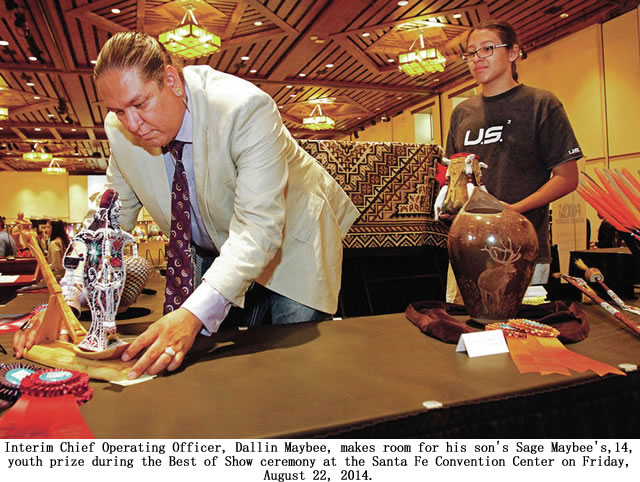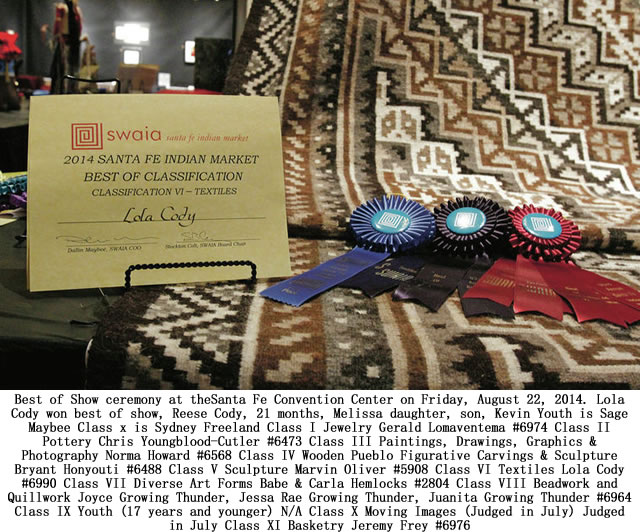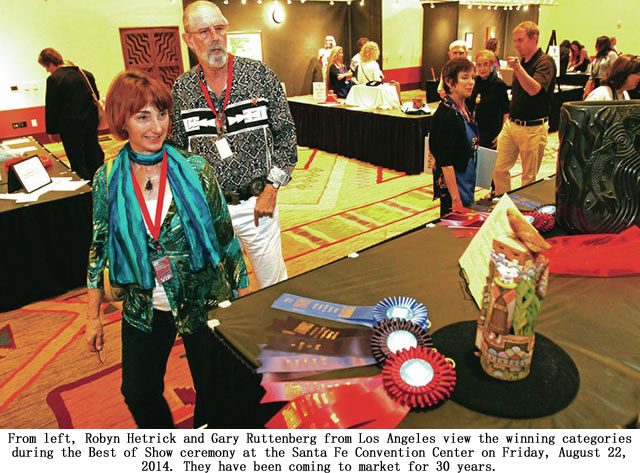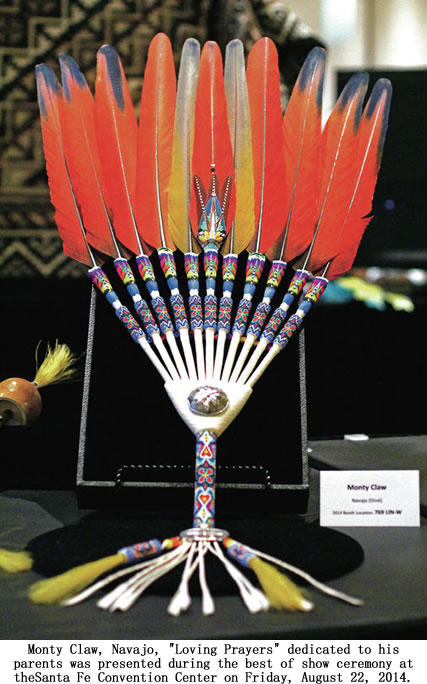 |
Canku Ota
|
 |
|
(Many Paths)
|
||
|
An Online Newsletter
Celebrating Native America
|
||
|
October 2014 - Volume
12 Number 10
|
||
|
|
||
|
Navajo Weaver's Rug
Wins Indian Market Best of Show
|
||
|
by Phaedra Haywood -
The (Santa Fe) New Mexican
|
||
|
credits: all photos by
Jane Phillips - The (Santa Fe) New Mexican
|
|
From shearing the sheep to spinning the wool to weaving the pattern, Navajo weaver Lola Cody spent almost two years making the rug that won Best of Show at this year's Santa Fe Indian Market. She said the weaving portion alone took her eight months "weaving every day, up to 14 hours a day."
The piece measures 8 feet by 13 feet 8 inches and is a "Two Grey Hills" pattern featuring the creams, browns and grays that occur naturally in the Churro sheep she and her husband raise in No Water Mesa, an area in the southwest corner of the Navajo reservation in Arizona.
The name of the piece, Sands of No Water Mesa, is inspired by the landscape around her home. "It's truly an honor to be here," Cody said Friday after learning she had won the market's highest award. "I never expected this, and it's been a long journey. Words can't express what I feel. Thank you, and I thank God." Cody said her husband "took over everything" while she was working on the piece the past few years. "He didn't complain," she said. "He took care of all our sheep."
When she began the piece last year, Cody said, her granddaughter had just been born, and she held the tiny baby on her lap as she wove. "This year, she sat next to me pounding away, pretending she was weaving," said Cody, her voice breaking. The weaver — who learned the art from her own mother and grandmother — said she hopes her granddaughter will be a weaver one day, too. Cody's piece also was awarded Best of Classification for the Textiles Division and beat out 10 other works of art that were selected as the best work in 10 other top categories, including jewelry, pottery, beadwork and quillwork. Southwestern Association for Indian Arts interim Chief Operating Officer Dallin Maybee said the award-winning works were selected from hundreds of entries submitted and judged on "technicality, aesthetic beauty and artistic talent" by Native art experts, gallery owners and others, including former U.S. Senator Ben Nighthorse Campbell. The winning works in the top 11 classifications and dozens of lower divisions were on display Friday at the Santa Fe Community Convention Center. Other works that received recognition Friday included a large Santa Clara-style black-on-black vase adorned with a relief featuring five koi fish made by ninth-generation Santa Clara potter Chris Youngblood Cutler, 24, who said he recently put his political science studies on hold to concentrate on making pottery full time. "To create, to get better and do to better work, I have to put more time into making it," said Youngblood Cutler, who credits his mother, Nancy Youngblood, with teaching him how to make pottery. Youngblood Cutler also credited his brothers for helping him fire the piece, which he said was "one of the scariest things" he'd every done.
Howard, who is of Choctaw and Chickasaw descent, said she had loved drawing since she was a child exploring the woods of Oklahoma, but her mother had told her that people didn't like Indians, so they wouldn't buy Indian art. Howard said she was 36 before she finally picked up a paintbrush. "Thank you, SWAIA, for giving that little bitty girl who played in the woods a chance to be here," Howard said tearfully when she was awarded her Best in Classification ribbon. "My history is in my family's story and in my heart and in my hands and in my eyes and in my paintbrush and my paper." Best in Classification awards also were given to Jeremy Frey, of the Passamaquoddy tribe in Maine, for a pottery-inspired basket woven from black ash and cedar bark and Marvin Oliver, of Quinault and Isleta Pueblo Heritage, for a glass piece titled We are Born From the River, which was inspired by baskets used for "dip fishing" for salmon in the Columbia River. Oliver said 12 other artists helped him create the piece, which took four people to lift and was dropped twice during its creation.
|
||||||||||||||
|
|
||
|
|
||
| Canku Ota is a free Newsletter celebrating Native America, its traditions and accomplishments . We do not provide subscriber or visitor names to anyone. Some articles presented in Canku Ota may contain copyright material. We have received appropriate permissions for republishing any articles. Material appearing here is distributed without profit or monetary gain to those who have expressed an interest. This is in accordance with Title 17 U.S.C. Section 107. | ||
|
Canku Ota is a copyright ©
2000 - 2014 of Vicki Williams Barry and Paul Barry.
|
||
 |
 |
|
|
The "Canku
Ota - A Newsletter Celebrating Native America" web site and
its design is the
|
||
|
Copyright ©
1999 - 2014 of Paul C. Barry.
|
||
|
All Rights Reserved.
|
||

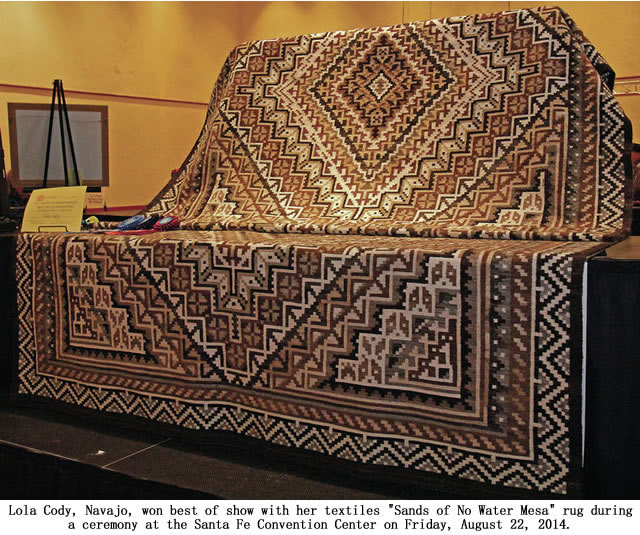
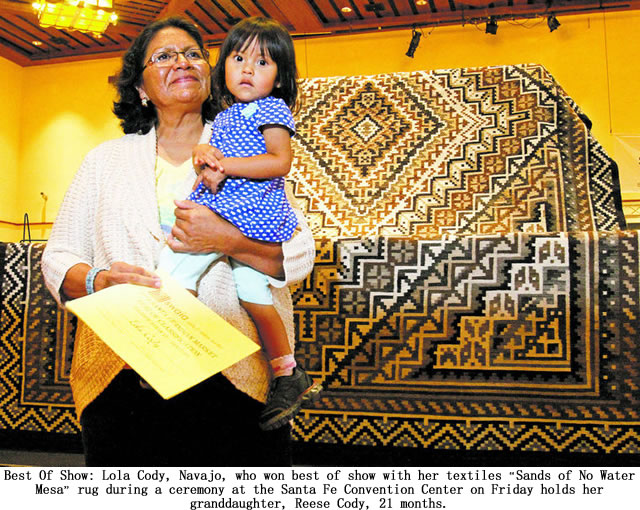
 The
top award in the Paintings/Drawings/Graphics/Photography classification
was given to a watercolor titled Choctaw Family Under a Brush Arbor
by Norma Howard.
The
top award in the Paintings/Drawings/Graphics/Photography classification
was given to a watercolor titled Choctaw Family Under a Brush Arbor
by Norma Howard.